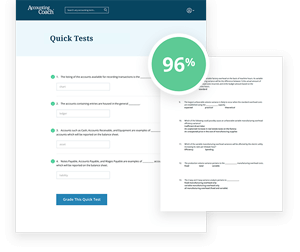For multiple-choice and true/false questions, simply press or click on what you think is the correct answer. For fill-in-the-blank questions, press or click on the blank space provided.
If you have difficulty answering the following questions, read our In-Depth Explanation for this topic.
The Same As
Different From
Balance Sheet
Cash Flow Statement
Income Statement
More Than One Will Be Needed
Longer
Shorter
Alphabetical Order
Company's Choice
Descending Order (largest To Smallest)
Order Of Liquidity
True
False
The Total Decreases By $10,000
The Total Increases By $10,000
The Total Remains The Same
The Total Decreases By $8,000
The Total Increases By $8,000
The Total Remains The Same
Its Liquidity Decreases
Its Liquidity Increases
Its Liquidity Is Unchanged
The Total Amount Of Current Assets
The Total Amount Of Current Liabilities
The Total Amount Of Assets
The Total Amount Of Liabilities
Acid Test Ratio
Current Ratio
Working Capital Ratio
Current Ratio
Quick Ratio
Aging Of Accounts Receivable
Current Ratio
Sales Journal
Trial Balance
Current Ratio
Inventory Turnover Ratio
Quick Ratio
Working Capital
Yes
No
Financing
Investing
Operating
Favorable
Unfavorable
Positive
Negative
Positive
Negative

Get Our Premium Working Capital and Liquidity Test Questions When You Join PRO
Receive instant access to our entire collection of premium materials, including our 1,800+ test questions.
View All PRO FeaturesFeatures
Free
PRO
Read 3,034 Testimonials